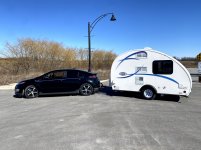So, for those who missed it in the other thread, we bought a trailer to tow with the Volt.

Went for the first test-tow today and got some if the nitty gritty details on how the car handled things.
From a physical standpoint the car is a champ at towing. Off the line it hauls effortlessly up to speed and I was easily able to pull away and leave cars in my dust at a green light, for example. It's stable as hell - coming back down highway 57 I could drive with just 2 fingers on the wheel if I wanted to and it just trucked along like there was nothing behind it. Stops great - didn't even really need the friction brakes, regen was doing probably 80% of the braking. I did one agressive brake application for a safety test and it hauled down fast. I do not have the trailer brakes hooked up yet (Trailer is only ~1500# so they're not even legally required, but it has them) and I'm not sure I'll bother now honestly - long gradual braking maximizes regenerative braking gains anyways which is beneficial so I'll take advantage of it.
The big question I had was...will the range extender keep up with the demands of towing.
I towed in "Mountain Mode" which is designed to hold the battery at 45%. At 45% SOC in mountain mode things went well until I got out on the road at 90KPH and with some hilly terrain. Despite the engine running (as in Mountain Mode it's supposed to maintain 45%, the part between 22% and 45% being the "climbing a bit hill" (IE, Mountains) buffer. However I slowly watched (on my OBD2 tablet display) the car chew that buffer up bit by bit, percent by percent.
The problem was...the engine was running, but the car refused to bring the RPM's up (& generate more) to compensate for the fact the buffer was depleting still. Only when it got down to about 19% did it start to realize something was up and slightly increased the RPMs - it seemed to hold its own at this point.
Until I got to some long hills. Admittedly I had it on cruise control and wasn't making any effort to back out of it as I wanted to see what happened - it climbed the grades like a champ while not loosing a single kph (honestly, the thing hauls like a champ!)...but the battery kept dropping.
At 16% the car goes into "Holy Shitballs" mode and the engine runs at the governor to generate maximum power and replenish the battery back to at least 22%. It runs at ~4100RPM...which given how soundproofed the Volt is really wasn't at all bothersome honestly. Below 16% it also dumps out into "Propulsion Reduced" mode which I
thought was going to be a big deal....IE, I can't even maintain my speed and I need to pull over big deal. But that wasn't the case. I did lose a little power but it kept pulling - I think it went down to 88kph (from a 90kph set cruise) despite being on a hill and once the hill was crested the car rebuilt the battery buffer and the car settled back into holding the 19-22% range.
Every slowdown through a town or at a traffic light allowed the system time to rebuild things even more as the car aimed to rebuild to the 45% mountain mode preset. Any downhill at <20% SOC dramatically and quickly increased SOC as not only was the engine putting out 35-40+Kw but the regen braking could be pushing out another 20-30kw.
So, I wasn't super happy about seeing SOC's down to the 15 range, but it was only there for a <60 seconds, and honestly, I probably shouldn't be worried even there as there's some software mods available in the aftermarket that do allow more of those buffer to be tapped to increase range anyways with zero effect on battery longevity years later. The buffers on the Volt were over-engineered and overkill. And of course as soon as you slow down or whatnot it rebuilds quickly. Would I want to run it below 10%? No...I don't want to tempt fate, but I'd just back off the go-pedal if things got that low.
Next weekend if the weather holds I'll take it out on the 401 and see what happens at 100kph versus 90kph.
This is where the Gen2 Volt apparently does better as it honks on the engine earlier to maintain the buffer versus letting it deplete. It also has a little more oomph behind the generator portion of the car.
On the bright side, all the operating temperatures stayed in a comfortable range, even the transmission - it topped out at 89c (194F) and then sat there for the most part which is from what I can gather perfectly acceptable and not uncommon to see in the summer. But I need to remember the ambient temp was zero celsius as well - question is...will temps stay low once summer hits. I'm prepared to install a secondary tranny cooler if need be to keep things safe.
Overall the fist tow was in general a great success. Would I take it out into the mountains? Nope. But that wasn't the goal with this setup.

 www.680news.com
www.680news.com



















